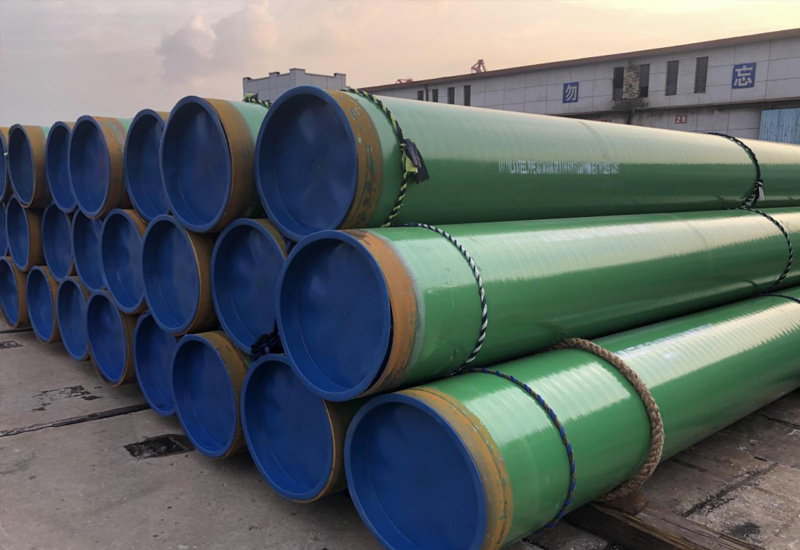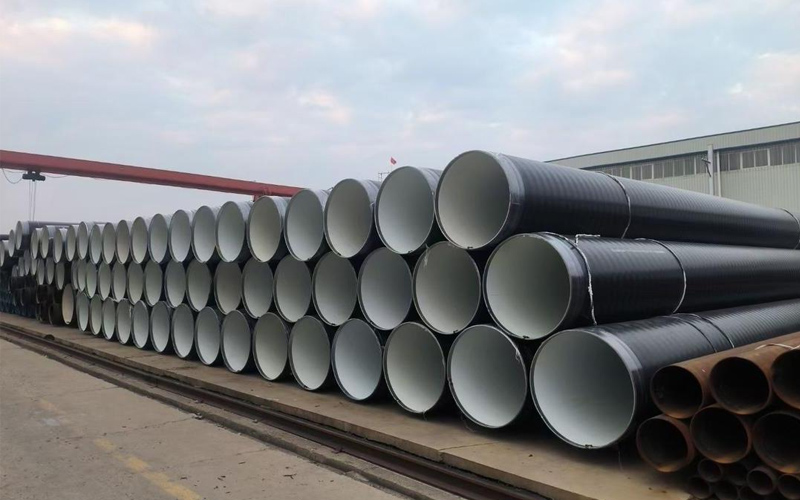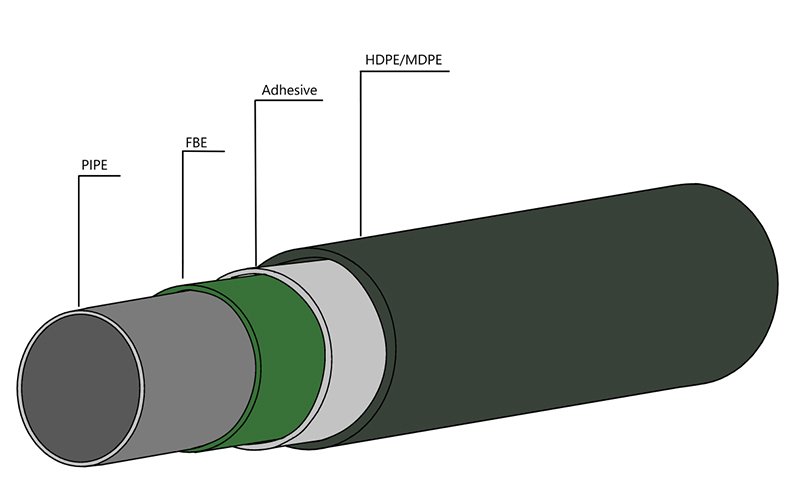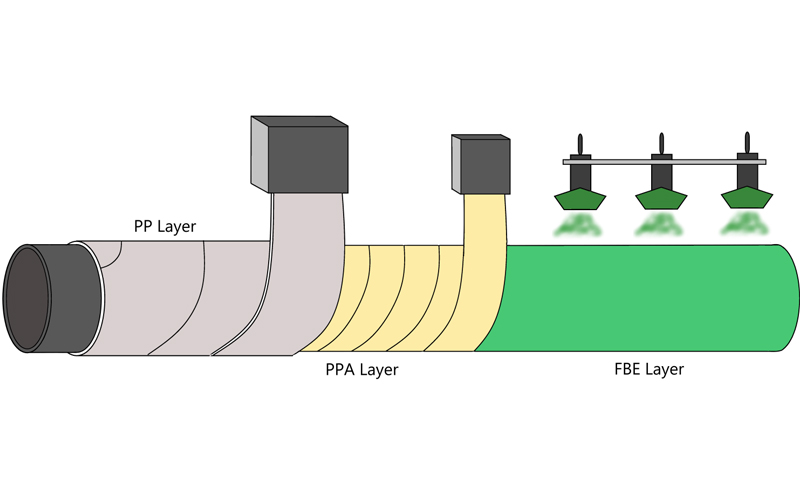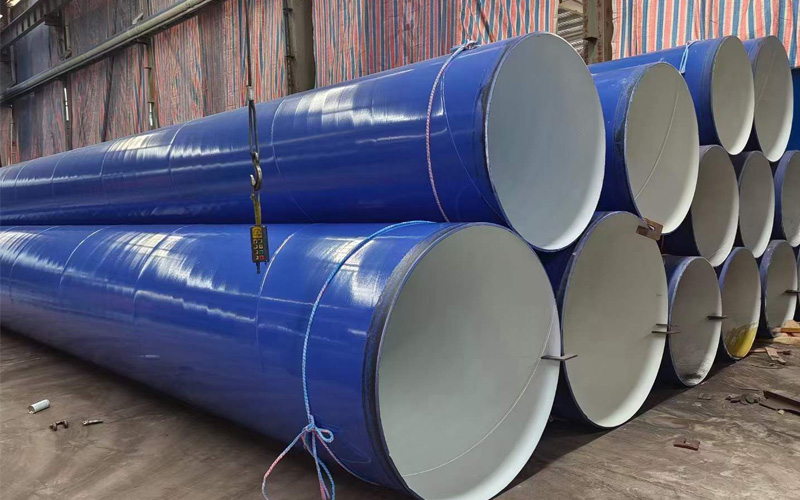A Guide to Pipe Selection for High-Sulfur Gas Fields
Today, with the continuous growth of energy demand, the development of high-sulfur Gas Fields (Sour Gas Fields) has become an important part of the global energy strategy. However, such gas fields contain large amounts of hydrogen sulfide (H₂S), carbon dioxide (CO₂), and other acidic components, posing a severe challenge to the collection, transportation, and processing equipment. Among them, hydrogen sulfide corrosion is one of the most significant risks leading to pipeline failure. It not only may cause huge economic losses but also may trigger catastrophic safety accidents.
H₂S corrosion mainly manifests in the following forms: hydrogen-induced cracking (HIC), sulfide stress corrosion cracking (SSCC), and electrochemical weight loss corrosion. The hydrogen atoms generated by the reaction between the wet H₂S environment and the surface of the steel pipe penetrate into the steel, accumulate and combine at inclusions or defects to form hydrogen molecules, generating huge pressure and causing internal cracks (HIC) to appear. Under tensile stress, these microcracks are highly prone to propagate into macroscopic cracks (SSCC), causing sudden brittle fracture of the pipeline. Such failures often occur without warning and are extremely harmful.
Therefore, in a high-sulfur natural gas environment, choosing anti-corrosion pipeline steel pipes is by no means a simple material selection, but a systematic project involving materials science, corrosion engineering, coating technology and quality control. This article will systematically expound on how to build a safe and reliable acid gas transportation pipeline through a comprehensive solution.
The first line of defense: Material selection that meets strict standards
Material selection is the cornerstone for resisting H₂S corrosion. The core principle is to select steel specifically designed for acidic environments, and the key lies in strict chemical composition control and advanced production processes.
The core position of the NACE MR0175/ISO 15156 standard
The international authoritative standard NACE MR0175 (now merged with ISO 15156) is the ultimate guideline for selecting materials for acidic environments. This standard not only specifies the chemical composition, mechanical properties and heat treatment process of steel, but also elaborates on the applicability of the material under specific H₂S partial pressure, pH value and chloride content environments.
Control of key chemical components
· Sulfur (S) content: It must be extremely low. Sulfur forms non-metallic inclusions such as MnS in steel, and these inclusions are the main source of HIC initiation. It is usually required that the S content be ≤ 0.002%.
· Phosphorus (P) content: It also needs to be strictly controlled as it will intensify the central segregation of steel, reduce toughness, and promote corrosion. The P content is required to be ≤ 0.015%.
· Calcium (Ca) treatment: Through the calcium treatment process, long strip-shaped MnS inclusions can be transformed into spherical CaS inclusions, thereby significantly reducing HIC sensitivity.
· Copper (Cu) content: An appropriate amount of Cu (0.2% – 0.3%) can form a protective oxide film on the surface of steel, enhancing its resistance to atmospheric corrosion. However, its impact on HIC needs to be comprehensively evaluated.
Table: Typical Chemical Composition Requirements for Pipeline Steel Used in Acidic Service Environments (Examples):
| Element | Standard Requirements (Typical Values, wt%) | Functions and Control Reasons |
| C | ≤ 0.06% | Reduce carbon equivalent, improve weldability and resistance to SSC |
| Mn | ≤ 1.30% | Excessive content will aggravate central segregation and needs to be controlled together with carbon content |
| S | ≤ 0.002% | Extremely low requirement to reduce MnS inclusions and prevent HIC initiation |
| P | ≤ 0.015% | Reduce cold brittleness and segregation |
| Ca | in moderation | Control inclusion morphology and transform type II sulfides into spherical ones |
| O | ≤ 0.002% | Reduce oxide inclusions and improve steel purity |
Microstructure and mechanical properties
Apart from the composition, a uniform and fine microstructure is the key to resisting HIC and SSCC. The acicular ferritic pipeline steel produced by the thermal mechanical control process (TMCP) has excellent comprehensive performance. Its high strength, high toughness and uniform microstructure can effectively prevent the initiation and propagation of cracks.
· Special attention should be paid to mechanical properties:
Hardness control: NACE MR0175 has a definite upper limit for the hardness of weld seams and heat-affected zones (HAZ) (typically HRC 22). The higher the hardness, the more likely SSCC is to occur.
· Yield strength: Although high-strength steel can thin the pipe wall, in an ultra-high H₂S environment, the conventional custom yield strength should not exceed 80ksi (550MPa) to ensure sufficient resistance to SSC.
The second line of defense: Advanced coating system
Even if the best pipe material is selected, a high-performance external anti-corrosion coating is indispensable. As a physical barrier, it isolates the steel pipe from moist, chloride-rich soil or Marine environments, which is the key to extending the pipeline’s lifespan and ensuring its integrity.
Coating selection: 3LPE vs. 3LPP
In harsh environments, three-layer polyethylene (3LPE) and three-layer polypropylene (3LPP) are currently the mainstream and most technologically mature coating systems.
· Three-layer polyethylene (3LPE)
Structure: Epoxy powder (FBE) bottom layer + polymer adhesive middle layer + polyethylene (PE) top layer.
Advantages: Excellent mechanical properties, cathodic disbondment resistance, and water resistance. The technology is mature and widely applied.
Limitation: The upper limit of temperature resistance of PE is usually 70°C. For high-temperature conveying conditions, its performance will decline.
· Three-layer polypropylene (3LPP)
Structure: Epoxy powder (FBE) bottom layer + polymer adhesive middle layer + polypropylene (PP) top layer.
Advantages: Outstanding high-temperature resistance (up to 125°C), higher mechanical strength, and better impact and wear resistance. It is highly suitable for high-temperature gathering and transportation pipelines, submarine pipelines or pipe sections that require directional drilling to pass through.
Cost: Usually higher than 3LPE.
| Performance Indicators | 3LPE | 3LPP |
| Maximum Operating Temperature | 60 – 70 °C | 100 – 125 °C |
| Impact Resistance | Good | Excellent |
| Adhesion Excellent | Good | Good |
| Flexibility | Excellent | Excellent |
| Chemical Resistance | Good | Good |
| Applicable Environments | Excellent | Excellent |
| Selection Suggestion | Most land and submarine environments | high temperature, rocky areas, directional drilling |
Selection suggestion: For high-sulfur natural gas fields, especially high-temperature flowlines near wellheads, 3LPP is often a better choice. Its higher temperature resistance and mechanical damage resistance provide additional guarantees for the long-term safe operation of pipelines.
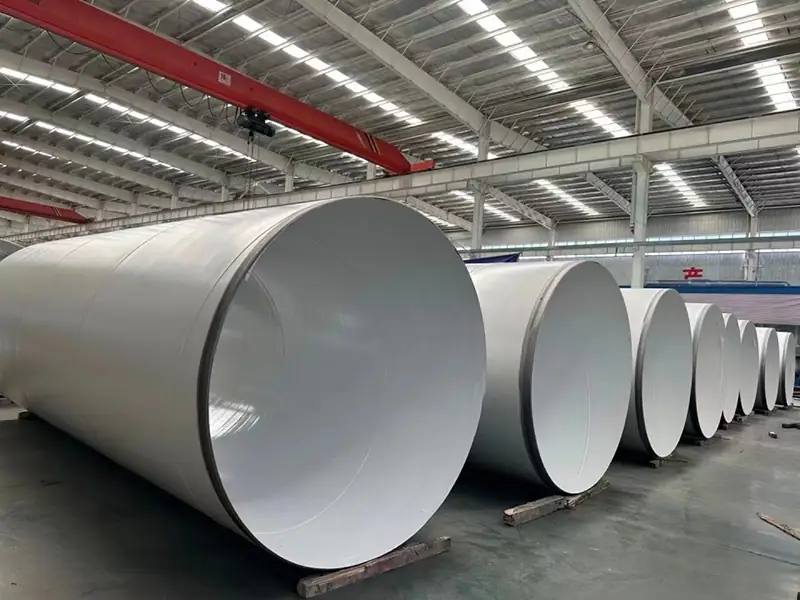
Our comprehensive solution for acidic service environments
The selection of anti-corrosion pipeline steel pipes is not an isolated decision, but a system that runs through the entire process from design, procurement, manufacturing, inspection to installation. The core of our solution is the three-in-one guarantee:
1. Strict control over raw materials and manufacturing
We start from the source and cooperate with top steel mills that comply with API 5L and NACE MR0175/ISO 15156 standards to ensure that the chemical composition and microstructure of the base material fully meet the standards. The steel pipe is formed by advanced JCOE/UOE forming process and double-wire/multi-wire submerged arc welding (SAW) technology, and is combined with online heat treatment to ensure that the performance of the weld seam and heat-affected zone (especially hardness) meets the requirements of acidic environment.
2. High-performance composite protection system
We recommend a composite protection solution of “anti-HIC /SSCC substrate + 3LPP (or 3LPE) outer coating + matching inner coating”.
Inner coating: Epoxy resin inner coating can be selected based on the gas quality conditions (such as containing CO₂) to reduce the contact of corrosive media on the inner wall and lower the frictional resistance of fluid transportation.
Cathodic protection: Designed in conjunction with the coating system as the final protective barrier.
3. Rigorous non-destructive testing and quality verification
Quality is designed and manufactured, and even more so, inspected. We carry out strict inspections far beyond the conventional projects:
HIC test: In accordance with the NACE TM0284 standard, A 96-hour immersion test was conducted in the solution (Solution A) simulating the service environment. Subsequently, the crack sensitivity rate (CLR), crack length rate (CTR), and crack thickness rate (CSR) were evaluated through ultrasonic scanning detection.
SSC test: In accordance with the NACE TM0177 standard, the four-point bending method or tensile test method was adopted to continuously load stress (usually 80% AYS) in saturated H₂S solution for 720 hours to verify its anti-SSCC performance.
Comprehensive UT/RT inspection: 100% ultrasonic and X-ray inspection is carried out on the pipe body and butt welds to ensure there are no defects at all.
Coating inspection: including holiday detection (leak detection), cathodic disbondment test, impact resistance test, etc.
A partner ensuring safety in harsh environments
The development of high-sulfur natural gas fields is a high-tech, high-risk and high-investment systematic project. Among them, the safety of the conveying pipeline is the lifeline of the entire project’s success. Simply choosing “high-grade” steel is not sufficient to address the unique challenges brought by H₂S.
The secret to success lies in the details: meticulous calculation of the percentage of chemical components, precise control of production process parameters, strict quality control of every millimeter of coating, and almost exacting non-destructive testing of every meter of steel pipe.
We are well aware that what we offer is not merely sections of steel pipes, but a weighty commitment to safety. As a long-term partner dedicated to providing harsh working condition solutions for the oil and gas industry, we, with our profound understanding of the standard system, strategic cooperation with top suppliers, and our own strong technical quality and project management capabilities, are able to offer customers comprehensive services ranging from technical consultation, material selection, pipe supply to on-site technical support.
Choosing us means you have chosen a reliable partner with the goal of zero failure. Let’s join hands to minimize the development risks of high-sulfur natural gas fields and jointly ensure the safety, efficiency and long-term effectiveness of energy transmission.
Get Your Custom Steel Pipe Quote Today!
Provide us with your project details (like application, specifications, quantity). Our experienced team will respond with a tailored solution and competitive quote within 24 business hours.
Related Articles
ASTM A53 vs. API 5L: A Guide to Selection and Application
Introduction:Technology differences determine success or failure, and selection needs to be “precise”
Steel Density Analysis: Core Differences between Mild and Medium Carbon Steels and Industrial Applications
3LPE coated steel pipe: a solid barrier in the field of industrial corrosion protection
3LPP coated pipe: anti-corrosion guard in high temperature and high pressure environment
FBE steel pipe: the technological armor of the steel defense line
HOT TAGS
近期文章
- Introduction:Technology differences determine success or failure, and selection needs to be “precise”
- FBE Steel Pipes: Corrosion Protection Redefined
- DIN 30671: A Guide to FBE Coating for Steel Pipes
- A Guide to Structural Pipe: ASTM A500vsEN10219
- Weld Seam Integrity: A Deep Dive into LSAW vs. SSAW Pipe




